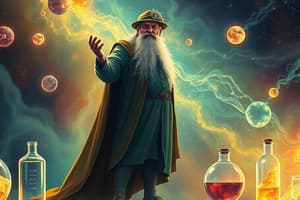Podcast
Questions and Answers
Who was the first to propose atoms?
Who was the first to propose atoms?
- Aristotle
- J.J. Thomson
- Democritus (correct)
- John Dalton
Aristotle agreed with Democritus' ideas about atoms.
Aristotle agreed with Democritus' ideas about atoms.
False (B)
What did John Dalton formulate?
What did John Dalton formulate?
Atomic Theory
According to Dalton's Atomic Theory, all matter is made of ______.
According to Dalton's Atomic Theory, all matter is made of ______.
Who discovered the first subatomic particle?
Who discovered the first subatomic particle?
What did Robert Millikan determine about electrons?
What did Robert Millikan determine about electrons?
The experiment used by Ernest Rutherford to discover the nucleus was called the ______.
The experiment used by Ernest Rutherford to discover the nucleus was called the ______.
Who created the Bohr Model of the Atom?
Who created the Bohr Model of the Atom?
Which scientist suggested the quantum mechanical model of the atom?
Which scientist suggested the quantum mechanical model of the atom?
What particle did James Chadwick discover?
What particle did James Chadwick discover?
Flashcards are hidden until you start studying
Study Notes
Ancient Philosophical Foundations
- Democritus (460-370 BC) proposed the concept of atoms, calling them "atomos," meaning "uncuttable."
- Aristotle (384-322 BC) rejected Democritus's idea, asserting that all matter consists of five elements: earth, water, air, fire, and aether.
Development of Modern Atomic Theory
- John Dalton (1766-1844) formalized Atomic Theory in 1808, establishing foundational concepts in chemistry.
- Dalton's Atomic Theory includes key principles such as:
- All matter consists of indivisible and indestructible atoms.
- Atoms of a given element are identical in mass and properties.
- Compounds form through combinations of different atoms.
- Chemical reactions involve rearrangements of atoms.
- Introduced Laws of Conservation of Mass, Definite Proportions, and Multiple Proportions.
Breakthroughs in Subatomic Particles
- J.J. Thomson (1856-1940) discovered the electron in 1897 using a cathode ray tube, proposing the Plum Pudding Model to illustrate atomic structure, which depicts electrons embedded in a positive sphere.
- Robert Millikan (1868-1953) measured the electron's negative charge through the oil drop experiment, achieved in 1910, and received the Nobel Prize in Physics in 1923.
Landmark Discoveries in Nuclear Structure
- Ernest Rutherford (1871-1937) identified the atomic nucleus via the Gold Foil Experiment in 1911, earning the Nobel Prize in Chemistry in 1908 for his contributions to radioactivity.
- Niels Bohr (1885-1962) introduced the Bohr Model in 1913, demonstrating that electrons orbit the nucleus in defined paths and can transition between energy levels.
Quantum Theories and Neutron Discovery
- Erwin Schrödinger (1887-1961) developed the quantum mechanical model in 1926, focusing on the probability of electron location, and formulated the Schrödinger equation, winning the Nobel Prize in Physics in 1933.
- James Chadwick (1856-1940) discovered neutrons in 1932, significantly enhancing the understanding of atomic structure, leading to a Nobel Prize in Physics in 1935.
Studying That Suits You
Use AI to generate personalized quizzes and flashcards to suit your learning preferences.




